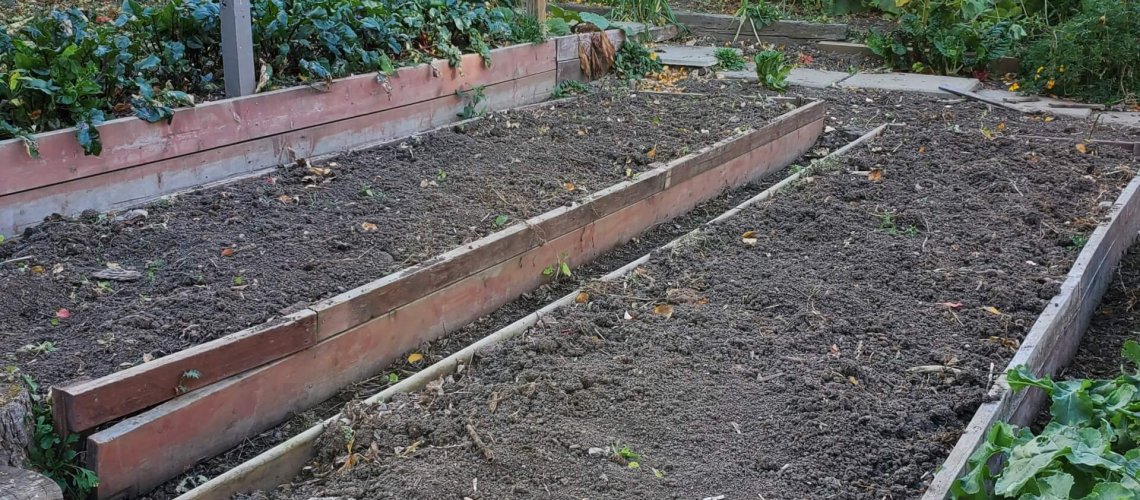In my first article, I talked about raised beds and methods of preparing the soil. I this article I will talk about composting and planning for the spring. And about gardening my way.
My method of composting starts with two large composting bins. The first is approximately eight feet by three feet by three feet high. The other is two feet shorter. Starting in year one, I fill the first one from August to the next July, occasionally layering plant material with soil. I put that compost on my beds in September. The plant material has decomposed for over a year and, while having some larger pieces, easily becomes incorporated into the top six inches of the beds. The second bin starts to be filled in August and is emptied the next fall. In other words, I fill each bin for 12 months before emptying it.
Once it has warmed up in the spring, I clean up the flower beds, having left the perennials allowing them to maximize the storage of nutrients in their roots for next year’s growth. I also prepare the raised beds for replanting. I put the flower bed material and any compost debris from the raised beds into the bins to decompose over the next year. I use little fertilizer, preferring to enrich my soil with compost.
In the fall, I also gather leaves from neighbors. Some go into the walkways between the raised beds, some as compost or mulch for winter protection, and some are saved for the next summer. In the next spring, the semi-composted leaves between the raised beds are placed on the raised and replaced with saved leaves. These in turn are used as mulch in the summer when the seedlings are large enough to need protection from drying.
Gardening starts in January or February, a time for planning: where to plant, what to plant, and when to plant. I use a four-year succession plan in my four larger raised beds. I have a four year-cycle with my four larger beds with carrots, beans, potatoes, and the cabbage family moving to the next raised bed each year. The rotation helps to prevent the depletion of the elements in soil (nitrogen, sulfur, phosphorous, and trace elements) while allowing plants such as peas or beans to add nitrogen to the soil. This also helps to some extent to fool the garden pests who tend to go back to last year’s feast to lay their eggs.
I have a sunroom with grow lights that I use for my seedlings. In early March I plant peppers, determinate tomatoes, and cucumbers in large containers that eventually go outside in late May. Indeterminate tomatoes (the vine type), flowers of all types, and herbs are planted in late March. I use a mixture of 1/3 garden soil, 1/3 compost, and 1/3 potting soil for the seedling pots. I do not use city compost because of the potential high salt content.
Depending on the weather and the long-range forecasts, I start planting the cool weather plants, carrots, beets, onions, bok choy, the cabbage family, Swiss chard, and spinach, as early as possible, sometime in late April or early May, depending on the long-range weather forecast. I wait for warmer weather in mid-May or later for pumpkin, squash, zucchini, beans, potatoes, cucumbers and transplanting the tomato seedlings. If we have a cold spell, I will use cloches to protect the tender seedlings. I plant squash and corn too early because of the long time to maturity, and plan to cover them or use cloches to protect them from a cold spell. I still start squash in the greenhouse and very carefully transplant it once it has warmed up; squash is very sensitive to disturbance.
Near the end of May, I put the containers of determinate outside. I also transplant the tomato seedlings and either stake them or plant them under a rope. As the determinate tomatoes grow, I tie them to stakes or twist the stem around the rope. In a good summer, they will eventually grow up to eight feet tall, bearing tomatoes all the way up. Tomatoes like heat, so I plant them against the west wall of our house, and in another warm area. Tomatoes thrive in the same area, year after year, and like compost made of tomato leaves and stems.
In my last next article, I will talk about weeding, watering, and harvesting.

One Response
Thanks for the info.
A FAMILY COOKBOOK
You liked your mother’s cooking; your father did some too
All those tasty recipes, were passed right on to you
Then all those times you tweaked them, just to call your own
And that smell that was created, filled your family home
“You need to eat your veggies”, I use to hear them say
Picked fresh from our garden, every summers day
Canning was a ritual, before cold weather came to call
We’d all be in the garden, harvesting every fall
Weeding, watering, picking, took up so much labor
Raspberries for the roughage, strawberries for the flavor
The chicken soup for healing, lasagna for the taste
The leftovers for tomorrow, so nothing goes to waste
In all those family memories, food was always there
Created with secret recipes, made with loving care
I go back there often, when I’m having a good dream
Such flavor in that pumpkin pie, served with farm fresh cream